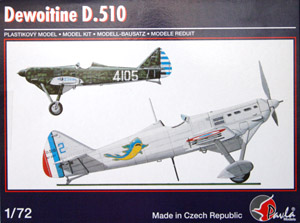Pavla 1/72 Dewoitine D.510
|
 |
Overview
The Dewoitine D.510 was an updated D.501, with a more powerful engine
and a three-bladed propeller, making it the final variant in the D.500
series. Over 100 were built, with 24 going to China. Other foreign operators
included Spain (receiving two D.510s in a roundabout manner), Japan (also
receiving two), England, and the Soviet Union (both receiving a single
D.510 each). The majority were used by the French, though, and saw limited
service at the opening of World War Two. The Spanish aircraft also saw
combat, but the majority of combat experience probably goes to the Chinese,
who used the type in the defense of Chengdu.
The Kit
 This
is not the first kit of the D.510, as Heller expanded their D.500 series
to include this type as well. However, that kit is rather old and very
weak in the details. This kit definitely surpasses the old Heller kit
in that regard, with its combination of injection plastic and resin details.
The nice decal sheet includes options for three French and one Chinese
aircraft, all very colorful options. This
is not the first kit of the D.510, as Heller expanded their D.500 series
to include this type as well. However, that kit is rather old and very
weak in the details. This kit definitely surpasses the old Heller kit
in that regard, with its combination of injection plastic and resin details.
The nice decal sheet includes options for three French and one Chinese
aircraft, all very colorful options.
Starting with the interior, this is all done in resin, with lots of
excellent detail. This is good, as the open cockpit will expose all of
this quite well. There is separate sidewalls, floor, control stick, rudder
pedals, seat, and instrument panel, all of which will really look good
after some careful detail painting. The completed assembly is then trapped
between the fuselage halves, and I would recommend plenty of test fitting
here to make sure all the edges are flush before tacking it in place.
The fuselage construction is somewhat complicated, given the shape of
the cowling. While the fuselage halves are mostly right and left pieces,
there is a separate upper cowling and a separate nose piece, required
to correctly capture the bulges on the nose. A resin ventral radiator
fairing is also separate, as is the rudder and some additional cowling
details. Again, it would be better to test fit often, than glue once and
fill repeatedly.
 With
the fuselage together, the rest of the assembly is very simple. The wings
and tailplanes are molded as upper and lower halves, with a butt-joint
to the fuselage. However, you will have to decide which option you are
building, as there are wing differences between the Chinese and French
aircraft. Beyond that, the rest of the assembly is just a matter of adding
struts and such to get the landing gear in place and tailplanes supported.
Speaking of landing gear, that too is different between the French and
Chinese options. If you like spats, you're going to have to build French. With
the fuselage together, the rest of the assembly is very simple. The wings
and tailplanes are molded as upper and lower halves, with a butt-joint
to the fuselage. However, you will have to decide which option you are
building, as there are wing differences between the Chinese and French
aircraft. Beyond that, the rest of the assembly is just a matter of adding
struts and such to get the landing gear in place and tailplanes supported.
Speaking of landing gear, that too is different between the French and
Chinese options. If you like spats, you're going to have to build French.
The decals are very nicely printed, and the options are some very colorful
aircraft. Starting with the sole Chinese option, this aircraft is in a
dappled camouflage of heavily weathered green over silver. Coded White
4105, this aircraft has the Chinese insignia on the lower wings only,
in addition to the blue and white striped rudder. For the French aircraft,
there are two silver and one camouflaged aircraft. The camouflaged one
is finished in a three-color camouflage and is from GC I/1 in 1939. The
two silver options are from GC II/8 and GC II/1, with a shark and a scythe-wielding
skeleton on the fuselages, respectively.
Conclusion
This is a welcome step above the existing D.510 kit out there, and one
which should be fun to build. The interesting history and colorful marking
options (both in the kit and elsewhere) will make this a popular French
subject to build. My thanks to Pavla
for the review sample.
|
|
